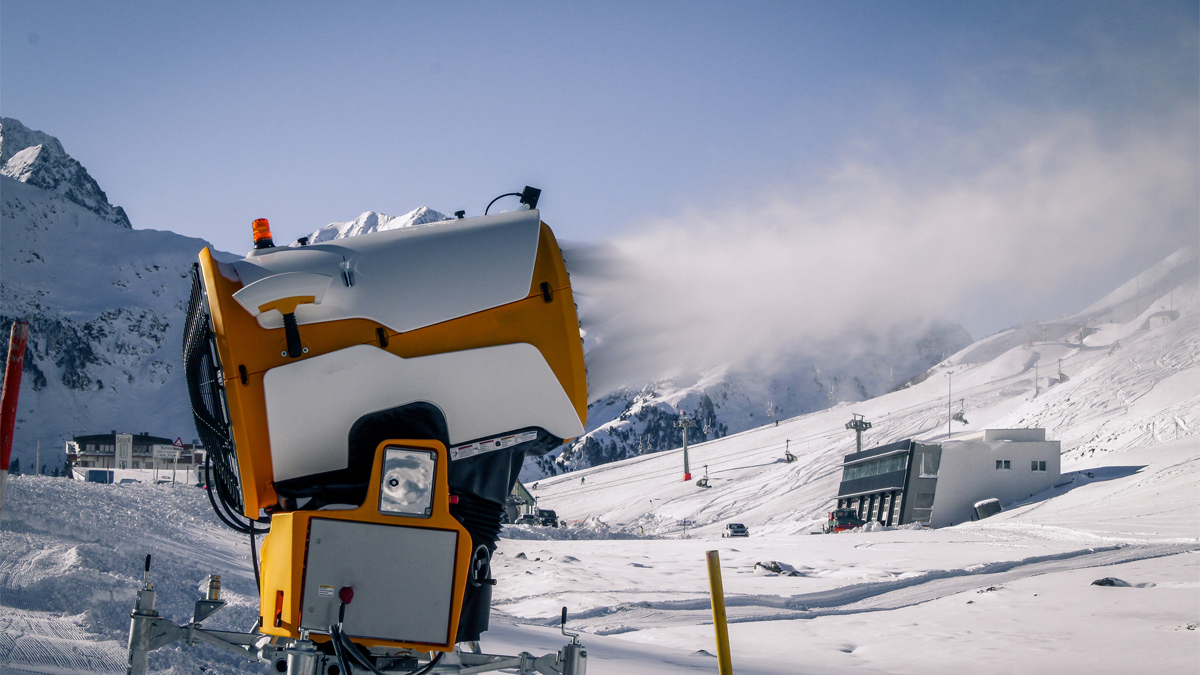In case you haven’t heard, the 2022 Winter Olympics is devoid of natural snow. As it turns out, China went to extreme lengths to ensure the games would have enough powder for competition by piping in the equivalent of 400 Olympic-sized swimming pools worth of water to various venues outside Beijing as part of a greater effort to make fluff. This marks the first time in Olympic history that nearly 100% of the competition snow is artificial, but by no means is it the first time winter-sports venues have relied heavily on technology to produce fake flakes.
Believe it or not, many of the world’s premier resorts and competitions rely heavily on man-made snow every single year. From Norway to Colorado, expensive snow-making equipment serves as a lifeline between recreationists and mountain locales, expanding the number of trails on which one can ride and the number of days they’re open and accessible. And while the history regarding artificial snow technology has rather innocent roots, in recent years, an over-reliance on it has become a symbol of our changing climate.
How to make fake snow
The origin story tells us that Canadian researchers were studying how ice forms on jet engines in the 1940s when someone sprayed water through an engine in a refrigerated chamber. The water immediately turned into snow, which skiers saw as an opportunity to produce flakes in larger quantities. Years later, New England became the first place in the world to commercialize the use of artificial snow. The process was widely adopted in the early ’70s and is used today by nearly every resort on the planet in some form.
So how does it work? Well, the process is rather simple. Water is pulled from a nearby source and mixed with compressed air before it’s atomized into fine droplets. Once shot through a nozzle, the droplets freeze instantly before mixing with larger droplets to create snow. It’s then blasted from a powerful, oscillating fan to cover as much as an acre of land at a time. This process is repeated again and again with an array of snow guns to cover a vast area. Modern snow cannons work best when temperatures are just below freezing, while chemical additives are needed to help the water crystallize when temperatures are higher.
A lack of efficiency and a changing climate
While the snowmaking process is relatively straightforward, it isn’t exactly efficient. To produce just one cubic meter of snow requires 1,000 liters of water, and some evidence suggests upwards of two-thirds of a resort’s energy usage is dedicated to making artificial snow each year. According to data from the Cableways Association of Switzerland, 53% of ski slopes in the Swiss Alps were artificially covered with snow during the winter of 2020-2021, and that proportion was higher in Italy and Austria.
Beyond the energy consumption, artificial snow also feels different. Unlike natural snow that’s fluffy and light, artificial snow is heavier, melts more quickly and therefore turns to ice more readily. Fortunately for Olympians, a harder, icier surface is often preferred, because competitors are looking for speed in, say, the super giant slalom (super-G). But for the rest of us that aren’t being timed as we cruise down a mountain, the lighter, fluffier stuff is preferred.
Perhaps most importantly, our reliance on artificial snow represents a drastically changing environment. Just last year, researchers from the Lawrence Berkeley Lab concluded that California’s Sierra Nevada snowpack could disappear by 2050, and snow in the Cascades and Rockies’ will follow shortly after. Similar studies have found that snow depth has declined across the European continent by 12% since 1951. And disappearing snowpack isn’t just bad for skiers — it also influences agricultural trends, water supply to major cities and local ecosystems that rely heavily on snowmelt.
As the 2022 Winter Olympics wrap up in the coming days, it’s important to understand not only the significant role artificial snow has played in competition but also what it represents. The process is far from efficient and continued reliance upon artificial snow could worsen the conditions that already lead to less snowfall. But such awareness and understanding is important regardless of how gloomy the outcome may seem. We know something is wrong. Now we need to do something about it.
Whether you’re looking to get into shape, or just get out of a funk, The Charge has got you covered. Sign up for our new wellness newsletter today.























